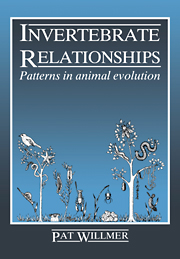Book contents
- Frontmatter
- Contents
- Acknowledgements
- Part I Introduction to animal phylogeny
- Part II Sources of evidence in invertebrate phylogeny
- Part III Phylogeny of major groups
- 7 The origin of the Metazoa
- 8 Acoelomates and other lowly worms
- 9 The pseudocoelomates
- 10 The phylogenetic position of molluscs
- 11 Arthropod phylogeny
- 12 The deuterostomes
- 13 The lophophorates
- 14 A phylogenetic overview of invertebrates
- References
- Index
11 - Arthropod phylogeny
Published online by Cambridge University Press: 08 January 2010
- Frontmatter
- Contents
- Acknowledgements
- Part I Introduction to animal phylogeny
- Part II Sources of evidence in invertebrate phylogeny
- Part III Phylogeny of major groups
- 7 The origin of the Metazoa
- 8 Acoelomates and other lowly worms
- 9 The pseudocoelomates
- 10 The phylogenetic position of molluscs
- 11 Arthropod phylogeny
- 12 The deuterostomes
- 13 The lophophorates
- 14 A phylogenetic overview of invertebrates
- References
- Index
Summary
Introduction
All the animals that are included within the arthropod assemblage show a degree of similarity frequently lacking in other groups that are nervertheless recognised without dispute as single phyla. For example it is quite easy to accept a relationship between all the leg-bearing spiders and insects, crabs and woodlice; but difficult to appreciate the common ancestry of the snails, clams and squids that together constitute the molluscs. It is therefore odd, at first sight, that there should be -particular disagreement about the status of arthropods as a single phylum.
Historically, theories involving monophyly certainly prevailed, and the occurrence of a major dispute about polyphyly is fairly recent. All the arthropods share a cuticle made of chitin and proteins, all show segmentation with at least some segments bearing paired articulated limbs, and all show rather similar patterns of cephalisation and pre-oral segments. Thus early authors found few problems in uniting them as a taxon, and the term ‘arthropod’ itself dates back to von Siebold in the mid-nineteenth century, coined as testimony to the jointed legs of all these animals. Through the nineteenth and early twentieth centuries the group retained its identity, either as a phylum or as a sub-group (with the annelids) of an even larger phylum called Articulata. The main features of the four principal types that constitute the arthropods (Crustacea, Insecta, Myriapoda and Chelicerata) are shown in table 11.1. Different phylogenetic schemes that have been proposed to link these four sub-groups together are usefully reviewed by Tiegs & Manton (1958); it is evident that essentially monophyletic schemes can differ enormously in detail, as virtually every possible pairing and hierarchy of groups has been attempted.
- Type
- Chapter
- Information
- Invertebrate RelationshipsPatterns in Animal Evolution, pp. 271 - 300Publisher: Cambridge University PressPrint publication year: 1990
- 2
- Cited by



